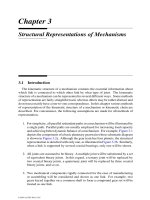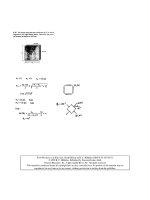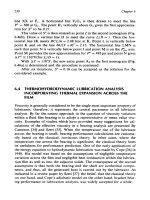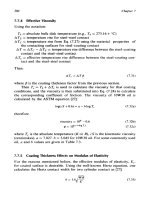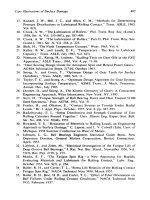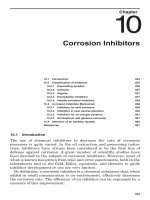ARNOLD, K. (1999). Design of Gas-Handling Systems and Facilities (2nd ed.) Episode 2 Part 8 docx
Bạn đang xem bản rút gọn của tài liệu. Xem và tải ngay bản đầy đủ của tài liệu tại đây (1.08 MB, 25 trang )
Figure
14*6.
Function chart.
Table
14-5
Safety
Device
Symbols
Sensing
and
Self-Acting Devices
Variable
Backflow
Burner Flame
Combustible
Gas
Concentration
Flow
Level
Safety Device
Designation
Common
Check Valve
Burner
Flame
Detector
Combustible
Gas
Detector
High Flow Sensor
Low
Flow Sensor
High
Level
Sensor
Low
Level Sensor
Instrument
Society
of
America
(I.S.A.)
Flow Safety Valve
Burner Safety
Low
Analyzer Safety High
Flow Safety High
Flow Safety
Low
Level Safety High
Level Safety
Low
(table
continued)
Pressure
Pressure
or
Vacuum
Vacuum
Temperature
Flame
High
Pressure Sensor
Low
Pressure Sensor
Pressure Relief
or
Safety
Valve
Rupture
Disc
or
Safety Head
Pressure-
Vacuum
Relief
Valve
Pressure-
Vacuum
Relief Manhole Cover
Vent
Vacuum
Relief
Valve
Rupture Disc
or
Safety Head
Fusible Material
High
Temperature Sensor
Low
Temperature Sensor
Flame
or
Stack
Arrestor
Pressure Safety High
Pressure
Safety
Low
Pressure
Safety
Valve
Pressure Safety Element
Pressure Safety Valve
Pressure Safety Valve
None
Pressure Safety Valve
Pressure Safety Element
Temperature
Safety
Element
Temperature Safety High
Temperature Safety
Low
None
(table
continued
on
next page)
Table
14-5 (Continued)
Safety
Device Symbols
Sensing
and
Self-Acting
Devices
Safety
Device
Designation
Symbol
Variable
Fire
Combustible
Gas
Concentration
Common
Flame Detector
(Ultraviolet/
Infrared)
Heat Dector
(Thermal)
Smoke
Detector
(lonization)
Fusible
Material
Combustible
Gas
Detector
Instrument
Society
of
America
(I.S.A.)
Temperature
Safety
High
Temperature
Safety
Element
Analyzer
Safety
High
Combination
Device
(table
continued)
14-6
Component
Identification
Common
Code Component
Modifiers
Code
Component
___
A
Atmospheric Vessel
BH, BJ,
BM
AA Bi
Directional User Assigned
(Ambient
Temperature)
AB
Blowcase Identification
Unique
B
Atmospheric Vessel
AP, BC, BK, BM AC
Boiler
to
Equipment
at
(Heated)
AD
Coalescer location
C
Compressor
AR, AS,
BA,
ZZ AE
Compressor
D
Enclosure
AE, AN, AU, BB AF
Contactor
E
Fired
or
Exhaust
AL,
AW, BN AG
Control Unit
Heated Component
AH
Departing
F
Flowline
A1-A9
AJ
Filter
G
Header
AR, AS,
AT,
AY,
AZ
AK
Filter-Separator
'
ohh
^,n*'r'l"-(f>
H
Heat Exchanger
BG AL
Forced
Draft
J
Injection Line
AR,
AS, AT AM
Free
water
Knockout
K
Pipeline
AA, AH, AQ AN
Generator
L
Platform
AG AP
Heater
M
Pressure Vessel
AB, AD, AF,
AJ,
AQ
Incoming
(Ambient
AK,
AM, AV, AR
Injection,
Gas
Temperature)
BD, BF, BH, AS
Injection,
Gas
Lift
BJ,
BL, BM AT
Injection, Water
N
Pressure Vessel
AC, AF,
AM,AP
AU
Meter
(Heated)
BC, BD, BG, AV
Metering Vessel
BJ, BK AW
Natural
Draft
P
Pump
AX, BA, BE AX
Pipeline
Q
Wellhead
AR, AT, AY, AZ AY
Production, Hydrocarbon
Z
Other
AZ
Production, Water
A1-A9
Flo
wline
Segment
BA
Process,
Other
BB
Pump
BC
Reboiler
BD
Separator
BE
Service
BF
Scrubber
BG
Shell
and
Tube
BH
Sump
BJ
Tank
BK
Treater
BL
Volume Bottle
BM
Water Treating
BN
Exhaust Heated
ZZ
Other
418
Design
of
GAS-HANDLING
Systems
and
Facilities
(text
continued
from
page
410)
HAZARDS
ANALYSIS
A
hazards analysis
is a
systematic procedure
for
identifying potential
hazards
which could exist
in a
facility, evaluating
the
probability
and
consequence associated with
the
hazard,
and
either reducing
the
proba-
bility
or
mitigating
the
consequence
so
that
the
overall risk associated
with
the
hazard
is
"acceptable."
The
different
hazards analysis techniques
can be
applied
at
various stages during
the
course
of the
project
to
assess
and
mitigate potential hazards during design, construction
and
operations
of
the
facility.
Types
of
Hazards
Analysis
Hazards
analysis techniques fall
in two
broad categories. Some tech-
niques
focus
on
hazards control
by
assuring that
the
design
is in
compli-
ance
with
a
pre-existing standard practice. These techniques result
from
prior hazards analysis, industry standards
and
recommended
practices,
results
of
incident
and
accident evaluations
or
similar facilities. Other
techniques
are
predictive
in
that they
can be
applied
to new
situations
where
such pre-existing standard practices
do not
exist.
The
most common hazards control technique
is a
"checklist."
The
checklist
is
prepared
by
experienced personnel
who are
familiar with
the
design, construction
and
operation
of
similar facilities. Checklists
are
rel-
atively
easy
to use and
provide
a
guide
to the
evaluator
of
items
to be
considered
in
evaluating hazards.
API RP 14J has
examples
of two
checklists which
can be
used
to
evaluate facilities
of
different
complexi-
ty.
Because production facilities
are
very similar
and
have been
the
sub-
ject
of
many hazard analyses,
a
checklist analysis
to
assure compliance
with
standard practice
is
recommended
for
most production facilities.
The
actual procedure
by
which
the
checklist
is
considered
and the
man-
ner
in
which
the
evaluation
is
documented
to
assure compliance varies
from
case-to-case.
The
most common predictive technique which
is
used
to
analyze
facil-
ities which contain
new
equipment
or
processes,
or
where there
is an
unusually
high
risk to
personnel
or the
environment
is the
Hazard
and
Operability technique
or
"HAZOP."
A
HAZOP study requires
a
team
of
five
to ten
multi-discipline personnel consisting
of
representatives
from
engineering,
operations,
and
health,
safety,
and
environmental
staff.
The
Safety
Systems
419
facility
is
broken down into
"nodes"
(usually
a
major
piece
of
equipment
and
its
associated piping, valves
and
instrumentation),
and an
experi-
enced team leader guides
the
team through
an
analysis
of
each node
using
a
predetermined list
of
"guide
words"
and
"process
parameters."
For
example,
the
guide word "LOW"
and
process parameter "PRES-
SURE" results
in
questions being asked
as to
potential causes
for
lower
than
design pressure
at the
node.
If the
condition
is
possible,
effects
are
analyzed
and,
if
necessary, methods
of
mitigation
are
added until
the risk
is
deemed
acceptable.
Although this method
is
time consuming,
it
proves
to be a
thorough method
of
analysis
and is
effective
for a new
process
which
has
never been analyzed before
or for a
known process
which
incorporates
new
equipment. However,
a
checklist should
be
used
in
con-
junction
with
a
HAZOP
to
assure that compliance
with
standard practice
is
not
inadvertently
overlooked
by the
HAZOP team.
Problems
Commonly
Encountered
There
are
several problem areas which seem
to
appear
often
in the
results
of
hazards analyses.
The
most common are:
1.
Relief Valve Sizes
Relief
valves
are
often
seen
to be
undersized
for the
required reliev-
ing
rate,
due
either
to
poor initial design
or
changes
in the
process
conditions
which occurred during design.
The
most common system
problem
is
that
the
relief valve
was
adequately sized
for
blocked
discharge
but not
sized
for the
flowrate
that could occur
as a
result
of
a
failure
in the
open position
of an
upstream control valve (i.e.,
gas
blowby).
See
Chapter
13.
2.
Open
and
Closed Drains
Another
common problem area
is
having open
and
closed drain sys-
tems tied together. Liquid which drains
from
pressure vessels
"flash"
at
atmospheric pressures giving
off
gas.
If
this liquid
flows
in
the
same piping
as
open drains,
the gas
will seek
the
closest exit
to
atmosphere
it can find,
causing
a
potential
fire
hazard
at any
open
drain
in the
system.
Many
accidents have occurred where
gas has
migrated through
the
drain
system
to an
unclassified area where welding,
or
other
hot
work,
was
being performed.
See
Chapter
15.
420
Design
of
GAS-HANDLING
Systems
and
Facilities
3,
Piping Specification Breaks
Piping
pressure ratings should
be
designed
so
that
no
matter
which
valve
is
closed,
the
piping
is
rated
for any
possible pressure
it
could
be
subjected
to, or is
protected
by a
relief valve.
When
a
spec
break
is
taken
from
a
higher
to a
lower MAWP, there
must
be a
relief valve
on the
lower pressure side
to
protect
the
piping
from
overpressure.
The
relief valve
can be
either
on the
piping
or,
more
commonly,
on a
downstream vessel. Spec break problems most
commonly occur where
a
block
valve exists
on a
vessel inlet,
or
where
a
bypass
is
installed
from
a
high pressure system, around
the
pressure vessel which
has a
relief valve,
to a
lower pressure
system.
4.
Electrical Area Classification
Another
common mistake
often
uncovered
is
electrical
equipment
which
is not
consistent
with
the
design area
classification.
See
Chapter
17.
SAFETY
MANAGEMENT
SYSTEMS
A
hazards analysis
by
itself cannot assure that
an
adequate level
for
safety
is
provided
for a
facility unless
the
hazard analysis
is
included
as
part
of a
comprehensive safety management system.
In the
United States
every facility handling highly hazardous chemicals, including some
onshore production facilities
and
most
gas
plants, must have
a
Process
Safety
Management (PSM) Plan
in
place.
Offshore
operators
have devel-
oped
a
voluntary
safety
management system presented
in API RP 75,
"Recommended Practices
for
Development
of a
Safety
and
Environmen-
tal
Management Program
for
Outer Continental Shelf (OCS) Operations
and
Facilities"
(SEMP), which
describes
the
elements which should
be
included
in a
safety management
plan.
The
requirements
of
both
PSM and
SEMP are,
from
a
practical stand-
point, identical
and
thus, SEMP
can
easily
be
applied
to
onshore facilities
as
well
as
offshore facilities.
The
basic concepts
of
SEMP
are as
follows:
Safely
and
Environmental
Information
Safety
and
environmental information
is
needed
to
provide
a
basis
for
implementation
of
further program components such
as
operating proce-
dures
and
hazards analysis. Specific guidelines
as to
what
information
is
needed
are
contained
in API RP
14J.
Safety
Systems
421
Hazards
Analysis
This
subject
is
addressed
in the
previous section
of
this
chapter.
Specif-
ic
guidelines
for
performing hazards analysis
are
contained
in API RP
14J.
Management
of
Change
Management
of
Change
is a
program that helps
to
minimize accidents
caused
by
changes
of
equipment
or
process
conditions
due to
construc-
tion,
demolition,
or
modification. Procedures should
be set up to
identify
the
various hazards associated with change.
All
changes, although some-
times
minor,
can
result
in
accident
and/or
injury
if
proper steps
are not
implemented
to
make operators aware
of the
differences. Changes
in
facilities
as
well
as
changes
in
personnel should
be
managed
to
maintain
the
safety
of all
personnel
and the
environment.
Operating
Procedures
The
management program should include written facility operating
procedures. These procedures should provide ample instruction
for
sound
operation
and be
consistent with
the
safety
and
environmental informa-
tion. Procedures should
be
reviewed
and
updated
periodically
to
reflect
current
process
operating practices. Procedures provide
the
means
for
education
of new
employees about
the
process
and
provide education
to
all
employees
on new
equipment
and
practices.
Safe
Work
Practices
A
disproportional
amount
of
accidents occur during construction
and
major
maintenance activities. Safe work practices
are
written with this
in
mind
and,
as a
minimum, should cover
the
following:
•
Opening
of
equipment
or
piping,
•
Lockout
and
tagout
of
electrical
and
mechanical energy sources,
«
Hot
work
and
other work involving ignition sources,
•
Confined
space entry,
and
«Crane
operations.
Training
Training
for new
employees
and
contractors,
and
periodic training
of
existing
employees
is
necessary
to
educate personnel
to be
able
to
per-
422
Design
of
GAS-HANDLING
Systems
and
Facilities
form
their work
safely
and to be
aware
of
environmental considerations.
Training
should address
the
operating procedures,
the
safe
work prac-
tices,
and the
emergency response
and
control measures.
Assurance
of
Quality
and
Mechanical
Integrity
of
Critical
Equipment
Procedures
for
assurance
of
quality
in the
design, fabrication,
installa-
tion,
maintenance, testing
and
inspection
for
critical equipment
are
required. Safety requires that critical
safety
devices must operate
as
intended
and
process system components must
be
maintained
to be
able
to
contain
design pressures.
Pre-startup
Review
A
pre-startup
safety
and
environmental review should
be
performed
on
all
modified
or
newly constructed
facilities.
Emergency Response
and
Control
An
Emergency Action Plan should
be
established, assigning
an
emer-
gency control center
and
appropriate personnel
for
emergency response.
Drills should
be
carried
out to
assure
all
personnel
are
familiar with these
plans.
Investigation
of
Incidents
An
investigation
is
required
if an
incident involving serious
safety
or
environmental
consequences
or the
potential
for
these
consequences
occurs.
The
purpose
of
such investigation
is to
learn
from
mistakes made
and
provide corrective action. Investigations should
be
performed
by
knowledgeable personnel
and
should produce recommendations
for
safer
working
conditions.
Audit
of
Safety
and Environmental
Management
Program
Elements
Periodically,
the
SEMP elements should
be
audited
to
evaluate
the
effectiveness
of the
program. Auditing should
be
conducted
by
qualified
personnel through interviews
and
inspections.
If
audits consistently
find
no
deficiencies
in the
program, then management should conclude
that
Safety
Systems
423
the
audit
is not in
itself
being done properly,
as
there
are
always
improve-
ments
that
can be
made
in a
safety management system.
SAFETY
CASE
AND
INDIVIDUAL
RISK
RATE
The
overall system
for
safety
described above
can be
called
the
"API
System,"
It is
based
on a
series
of API
Standards
and
Recommended
Practices
which
can be
summarized
as a
four
step system with each
suc-
ceeding
step encompassing
the
preceding steps:
1.
Design
and
maintain
a
system
for
process upset detection
and
shut-
down—RP
14C.
2.
Design
and
select
hardware with known reliability
and
mechanical
integrity
to
contain pressure
and
mitigate
failure
consequences—all
other
API RP 14
series standards.
3.
Follow system design concepts, documentation needs
and
hazards
analysis
requirements—RP
14J.
4.
Develop
a
management
of
safety
system—RP
75.
This system
has
proven
to
provide adequate levels
of
safety
in the
Gulf
of
Mexico
and
other similar areas where
it is
possible
to
abandon
the
location during
a
catastrophic event.
In the
North
Sea
where harsh envi-
ronmental conditions exist,
a
different
approach
to
safety
has
evolved
which
is
based
on
developing
a
Safety
Case
and
calculating
an
Individual
Risk
Rate
(IRR)
to
show that
the risk to any
individual working
in the
facility
is As Low As
Reasonably Practicable (ALARP).
A
Safety Case
is a
narrative that literally makes
the
case that
an
ade-
quate
level
of
safety
has
been reached
for an
installation.
It
requires look-
ing
at all
potential hazards which could lead
to a
loss
of the
installation,
a
loss
of
life,
or a
major pollution event.
A risk
analysis
is
performed
on
each hazard evaluating
the
probability
of the
event occurring
and
describing
the
magnitude
of the
consequences.
A
discussion
is
then given
of
the
measure undertaken
to
lower
the
probability
of
occurrence
or to
mitigate
the
consequences
and a
"case"
is
made that
the
risk
for the
installation
meets
the
ALARP
safety
criteria.
In
the
North
Sea
this
is
often
done with detailed quantified
risk
assess-
ments
and the
calculation
of an
overall
IRR or risk of
total loss
of
struc-
ture.
Mitigation measures
are
incorporated until
it can be
shown that
risk
levels
meet
a
minimum criteria
and the
cost
of
further
mitigation
has
such
high
cost
to
benefit
ratios that
further
mitigation
is no
longer
"practicable."
424
Design
of
GAS-HANDLING
Systems
and
Facilities
These analyses tend
to be
rather
long
and
complex
and can
negatively
impact
both project cycle time
and
cost.
Indeed,
as a
check
to
assure that
basic
known
safety
concepts
are not
inadvertently
overlooked
in the
pile
of
documentation which
is
necessary
for a
safety
case,
the
safety
case
approach should include
within
it all the
elements
of the
"API System,"
Even
if a
safety
case
is
performed,
it is
still
necessary
to
assure compli-
ance
with good practices
and
that
all
elements
of a
proper
safety
manage-
ment
system
are
included. Thus
a
common sense approach
in the
absence
of
government regulation would
be to use the
API
System
for roost
installations
and,
in
those instances where there
is a
large concentration
of
personnel
or
where abandoning
the
location
may be
impossible
due to
weather
or
remoteness,
to use a
qualitative
safety
case
to
think
through
fire
fighting
and
escape
options.
CHAPTER
15
Valves,
Fittings,
and
Piping
Details*
The
various items
of
equipment
in the
production
facility
are
connected
by
valves, fittings,
and
piping
to
enable
and
control
flow
from
one
piece
of
equipment
to
another. Chapter
9 of
Volume
1
discusses
factors govern-
ing
the
choice
of
line size
and
wall thickness. This chapter
describes
the
various
types
of
valves
and
fittings
commonly used
in
production
facili-
ties
and
presents some common piping
details
and
specifications.
The
specific piping details used
in a
project
are
normally contained
in
a
company pipe, valve,
and
fittings
specification, which addresses
the
following
subjects:
1.
Governing industry codes.
2.
Material requirements
for
pipe,
flanges,
fittings,
bolts,
nuts,
and
gaskets.
3.
Material
and
construction
for
each valve used
in the
piping.
4.
Pipe schedule
and end
connection
for
each service
and
pressure rating.
*Reviewed
for the
1999
edition
by
Jorge
Zafra
of
Paragon
Engineering Services,
Inc.
425
426
Design
of
GAS-HANDLING
Systems
and
Facilities
5.
Welding certification
and
inspection requirements.
6,
Design details
(if not
already included
in
drawings).
For
example,
branch connections, pipe support spacing
and
details,
clearances,
and
accessibility.
In
order
to
cover
all the
lines
in the
facility, pipe
and
valve tables
are
normally
included. Each pipe pressure class
is
assigned
a
designation.
Sometimes
it is
necessary
to
assign
two
classes
for a
single
designation.
For
example,
in
Table
15-1
"A,"
"L,"
and
"AA"
are all
ANSI
150
class,
but
they contain
different
fluids.
A
separate table such
as the
example
in
Table
15-2
is
prepared
for
each
line
designation. Each valve
is
assigned
a
designation
on the flowsheets and
explained
in
this
table.
The
pipe,
valves,
and
fittings table
can
specify
acceptable valves
by
manufacturer
and
model number,
by a
generic
descrip-
tion,
or by a
combination
of the two as
shown
in the
example.
It
should
be
pointed
out
that Tables
15-1
and
15-2
are
examples
from
American Petrole-
um
Institute Recommended Practice (API
RP)
14E and are
illustrative only.
There
are
almost
as
many
different
formats for
pipe, valve,
and fittings
tables
as
there
are
companies,
and
these examples
are in no
manner typical
or
recommended. Often,
for
simplicity, valve types
are not
described
in the
pipe,
valve,
and fittings
specifications
but on
separate sheets
for
each
valve
designation,
as
discussed below under
Valve
Selection
and
Designation.
VALVE
TYPES
The
following descriptions
are
meant
to
briefly describe
the
various
generic
valve
types. Within each type there
are
numerous
different
design
details that separate
one
valve manufacturer's valves
from
the
next.
All
of
these specific models have good points
and bad
points;
all can be
used
correctly
and
incorrectly.
It is
beyond
the
scope
of
this
book
to
critique
each
valve manufacturer's design. However,
the
various valve salesmen
will
be
more than
pleased
to
contrast
the
benefits
of
their
valve's
features
with
that
of the
competition.
The
reader
is
cautioned that higher-cost
valves
do not
necessarily mean better valves,
and
that expensive valves
can
result
in a
significant waste
of
money when
a
less
expensive
but
ade-
quate
valve will perform satisfactorily.
Ball
Valves
This
is a
quarter-turn
on-off
valve (Figure
15-1).
A
bore
through
the
ball allows
flow
when
it is
lined
up
with
the
pipe
and
blocks
flow
when
it
Valves,
Fittings,
and
Piping Details
427
Table
15-1
Example
Index
of
Pipe,
Valves,
and
Fittings
Table
A
B
C
D
E
F
G
H
I
J
K
L
M
N
0
P
(Spare)
Q
(Spare)
R
(Spare)
SV
AA
BB
CC
(Not Prepared)
DD
EE
FF
GG
Service
Non-corrosive Hydrocarbons
and
Glycol
Non-corrosive Hydrocarbons
and
Glycol
Non-corrosive Hydrocarbons
and
Glycol
Non-corrosive Hydrocarbons
and
Glycol
Non-corrosive Hydrocarbons
and
Glycol
Non-corrosive Hydrocarbons
and
Glycol
Non-corrosive Hydrocarbons
and
Glycol
Non-corrosive Hydrocarbons
Non-corrosive Hydrocarbons
Non-corrosive Hydrocarbons
Non-corrosive Hydrocarbons
Air
Water
Steam
and
Steam
Condensate
Drains
and
Sewers
Valves
for
Corrosive Service
Corrosive Hydrocarbons
Corrosive Hydrocarbons
Corrosive Hydrocarbons
Corrosive Hydrocarbons
Corrosive Hydrocarbons
Corrosive Hydrocarbons
Corrosive Hydrocarbons
Pressure
Kanng
Classification
ISOlbANSI
300
Ib
ANSI
400
Ib
ANSI
600
Ib
ANSI
900
Ib
ANSI
1
500
Ib
ANSI
2500
Ib
ANSI
API
2000
psi
API
3000
psi
API
5000
psi
API
10000
psi
ISOlbANSI
1
25
Ib
Cast Iron
300
Ib
ANSI
Atmospheric
General
ISOlbANSI
300
Ib
ANSI
400
Ib
ANSI
600
Ib
ANSI
900
Ib
ANSI
1
500
Ib
ANSI
2500
Ib
ANSI
is
perpendicular
to the
pipe.
A
"regular
port"
ball valve
has a
bore diame-
ter
less than
the
pipe inside diameter, while
a
"full
opening" ball valve
has a
ball diameter equal
to the
pipe inside diameter.
Ball
valves
are
limited
in
temperature
by the
elastomer material used
in
their
seats.
Many
designs have
a
secondary
metal-to-metal
seat
to
pro-
vide
a
seal
in
case
of
fire.
Ball valves
are not
suitable
as a
throttling
valve,
but can be
used
on
start-up
and
shut-down
in the
partially open
position
to
bleed pressure into
or out of a
system.
These valves
are the
most common
general-purpose
on/off
valves
in
production
facilities.
(text
continued
from
page
430)
428
Design
of
GAS-HANDLING
Systems
and
Facilities
Table
15-2
Example
Specifications
of
Pipe,
Valves/
and
Fittings
150-lbANSI
Non-corrosive
service
1
Temperature
range;
-20 to
650"F
Maximum
pressure:
Depends
on flange
rating
2
at
service
temperature
Size Ranges General Specifications
Platform
Service
Pipe
Grade depends
on
service ASTM A106,
Grade
B,
Seamless
3
M-in.
and
smaller threaded
and
coupled Schedule
160 or XXH
nipples
1
!^~in.
and
smaller
threaded
and
coupled Schedule
80 min
pipe
2-in 3-in.
pipe beveled
end
Schedule
80 min
4-in.
and
largei
pipe beveled
end See
Table
2-4
Valves
(Do
no1 use for
temperatures above maximum indicated.)
Ball
'/-in.
and
smaller
1500
Ib
CWP
ANSI
316 SS
Manufacturer's Figure
screwed, regular
port.
No.
(300°F)
wrench
operated, Teflon
seat
%-in,-l
M-in.
1500
Ib
CWP,
CS,
Manufacturer's
Figure
screwed, regular
port.
No. or
Figure
wrench
operated.
Teflon
No.
(450°F)
seat
2-in 8-in.
1
50
Ib
ANSI
CS RF
Etc.
flanged,
regular
port,
lever
or
hand
wheel
operated,
trunnion
mounted
1
0-in.
and
larger
1
50
tb
ANSI
CS RF
Etc.
flanged,
regular port, gear
operated, trunnion mounted
Gate
!/-in.
and
smaller
2000
Ib
CWP, screwed, Etc.
bolted bonnet,
AISI
316 SS
%-in l
J^-in.
2000
Ib
CWP, screwed, Etc.
bolted bonnet, forged steel
2-in-l
2-in.
1
50
Ib
ANSI
CS RF
Etc.
flanged,
standard trim,
hand
wheel
or
lever
operated
Valves,
Fittings,
and
Piping
Details
429
Table
15-2
(Continued)
Example
Specifications
of
Pipe/
Valves,
and
Fittings
Globe
I
fc-in. and
smaller
2000
Ib
CWP
CS
screwed
Etc.
(Hydrocarbons)
1
^-in.
and
smaller
2000
Ib
CWP CS
Etc.
(Glycol)
socketweld
2-in.
and
larger
150
Ib
ANSI
CS RF
Etc.
flanged,
handwheel
operated
Check
1
VS-in.
and
smaller
600
Ib
ANSI
FS
screwed,
Etc.
bolted
bonnet
4
,
standard
trim
2-in.
and
larger
150
Ib
ANSI
CS RF
Etc.
flanged,
bolted
bonnet
4
,
swing
check, standard trim
Reciprocating
300
Ib
ANSI
CS RF
Etc.
Compressor Discharge flanged, piston, check,
bolted
bonnet
4
Lubricated
Plug
lM-in 6-in.
150
Ib
ANSI
CSRF
Etc.
flanged,
bolted bonnet
Non-lubricated
Plug
1
J4-in 6-in.
150
Ib
ANSI
CS RF
Etc.
flanged,
bolted
bpmmet
Compressor
Laterals
Use
ball
valves
Needle
!4-in ^-in.
6000
Ib
CWP,
bar
stock
Etc.
screwed,
AISI316
SS
Fittings
Ells
and
Tees
%-in.
and
smaller
6000
Ib
FS
screwed ASTM
A105
l-in l
l
/*-in.
3000
Ib
FS
screwed ASTM A105
2-in.
and
larger
Butt
weld, seamless, wall ASTM A234, Grade
to
match pipe
WPB
Unions
M-in.
and
smaller
6000
Ib
FS
screwed, ground ASTM
A105
joint, steel
to
steel seat
l-in l
J4-in.
300Q
Ib
FS
screwed, ground ASTM A105
joint, steel
to
steel seat
2-in.
and
larger
Use flanges
(table
continued
on
next page)
430
Design
of
GAS-HANDLING
Systems
and
Facilities
Table
15-2
(Continued)
Example
Specifications
of
Pipe,
Valves,
and
Fittings
Couplings
1
-in.
and
smaller
6000
Ib
FS
screwed ASTM
A105
1
J4-in.
3000
Ib
FS
screwed ASTM
A105
Plugs
1
!44n,
and
smaller Solid
bar
stock,
forged
steel ASTM
Al
05
2-in.
and
larger
X-Strong
seamless, weld ASTM A234,
cap
Grade
WPB
Screwed
Reducers
M-in.
and
smaller Sch.
160
seamless ASTM
A105
1-in-l
14-in.
Sch.
80
seamless ASTM
A105
Flanges
1
^-in.
and
smaller
150
Ib
ANSI
FS RF
ASTM
A105
screwed
2-in.
and
larger
150
Ib
ANSI
FS RF
weld ASTM
A105
neck,
bored
to
pipe schedule
Bolting
Studs
Class
2 fit,
threaded over ASTM A193, Grade
length
B7
4
Nuts
Class
2 fit,
heavy
hexagon, ASTM
A194,
Grade
semi-finish
2H
4
Gaskets Spiral wound asbestos Spiral Wound Mfg.
Type
or
Mfg.
No.
w/AISI
304 SS
windings
Thread
Lubricant
Conform
to API
Bulletin
Mfg.
No.
5A2
Notes:
l
For
glycol
service,
all
valves
and
fittings
shall
be flanged or
socketweld.
2
API
5L,
Grade
B,
Seamless
may be
substituted
if
ASTM
A106,
Grade
B,
Seamless
is not
available.
3
Studs
and
nuts shall
be
hot-dip galvanized
in
accordance with ASTM
A153.
4
Fittings
and flanges
that
do not
require
normalizing
in
accordance with
ASTMA105,
due to
size
or
pressure rating, shall
be
normalized when
used
for
service temperatures from
~20°F
to
60°F.
Fittings
and flanges
shall
be
marked
HT,
N, * or
with some other
appropriate
marking
to
designate normalizing,
(text
continued
from
page 427)
Plug
Valves
Plug
valves
are
similar
to
ball valves
except
a
cylinder with
a
more-or-
less
rectangular
opening
is
used
instead
of a
ball
(Figure
15-2). Plug
valves cannot
be
made
full
opening
and are
limited
in
temperature
rating
by
the
rating
of
their
elastomer
seats.
Figure
15-1.
Cutaway
of
ball
valve.
(Courtesy
of
Cameron Iron
Works,
Inc.]
Figure
15-2.
Cutaway
of
plug
valve.
(Courtesy
ofXomox
Corp.)
432
Design
of
GAS-HANDLING
Systems
and
Facilities
Plug
valves usually require lubrication
on a
regular
basis
to
seal.
They
tend
to
have
a
more unpredictable torque
than
ball valves
and are
thus
hard
to
automate.
As
with ball valves, plug valves
are
on/off
valves
and
should
oaly
be
used
infrequently
in
throttling service. They tend
to be
less expensive
than
ball
valves,
but are not as
popular because
of
their need
for
lubrication.
Gate
Valves
A
gate valve seals
off
flow
when
a
slab
is
either raised (normal acting)
or
lowered (reversed acting)
so
that
the
hole through
the
slab
no
longer
lines
up
with
the
pipe (Figure 15-3), Gates
are
harder
to
operate manual-
ly
than
balls
or
plugs
as
they take many turns
of the
handwheel
to
open
or
close
the
valve. However, this action
is
easier
to
automate
with
a
power
piston than
the
quarter-turn action required
for
balls
and
plugs,
An
unprotected rising stem that
is
corroded
or
painted
can
make
the
valve
difficult
to
operate. Stem protectors
and
keeping
the
stem packed
in
grease help alleviate this problem.
Gate valves
are
on/off
valves
and
should never
be
used
for
throttling.
Gate
valves
are
usually less expensive than balls
or
plugs
in
high-pres-
sure
service
or for
large pipe sizes. They make excellent high-pressure
flowline
and
pipe
shut-in valves,
but are not
extensively
used
in
normal
facility
piping
12 in. and
smaller
in
diameter.
Butterfly
Valves
These valves
are
relatively
inexpensive, quarter-turn valves.
The
seal
is
made
by a
rotating
disc
that remains
in the flowstream
subject
to
ero-
sion
while
in the
open position (Figure
15-4).
Except
in
low-pressure ser-
vice,
they should
not be
used
to
provide
a
leak-tight
seal,
but
they
can be
used
to
throttle where
a
tight shut-off
is not
required.
Butterfly
valves
are
particularly
useful
in
low-pressure produced water
service
and
as gas
throttling valves
on the
inlets
of
compressors.
Globe
Valves
The
most common valve construction
for
throttling service,
and
thus
for
automatic
control,
is a
globe valve (Figure 15-5).
The
movement
of the
stem
up or
down creates
an
opening between
the
disc
and
seat that allows
fluid
to
pass through
the
valve.
The
greater
the
stem movement,
the
larger
the
annulus
opening
for fluid flow.
Because
only
a
small stem movement
is
Valves,
Fittings,
and
Piping Details
433
Figure
15-3.
Cutaway
view
of
gate
valve.
(Courtesy
of
WKM.)
required
from
the
fully
closed
to
fully
open positions, globe valves
are
easy
to
automate
with
a
diaphragm operator
as
shown
in
Figure
15-6.
Globe valves have
metal-to-metal
seats,
which
are
easy
to
replace.
Because
of the
erosive action
of the
fluid
when
the
valve
is
throttling, they
should
not be
used
for
on/off
service,
A
tight
seal
may not be
possible,
434
Design
of
GAS-HANDLING
Systems
and
Facilities
Figure
15-4.
Butterfly
valve.
(Courtesy
or
Keystone
Valve
USA,
Inc.)
Figure
15-5.
Cutaway view
of
globe
valve.
(Courtesy
of
Jenkins
Bros.)
Valves,
Fittings,
and
Piping
Details
43S
Figure
15-6.
Typical
single-port
body
control
valve
(left)
and
pneumatic
actuator
fright). (Courtesy
of
Fisher
Controls
International,
Inc.]
There
are
many configurations
of
plugs
and
seats
("trim")
that create dif-
ferent
control
responses.
The
design specification
of
control valves
is
beyond
the
scope
of
this book.
Diaphragm
(Bladder)
Valves
These special throttling valves
use an
elastomer diaphragm
to
restrict
or
stop
flow
(Figure 15-7). They
are
suitable
for
slurry service
and
make
an
excellent valve
for
sand drains. Unfortunately, they
do not
provide
a
reliable, positive
shut-off
and
should
be
installed
in
series
with
a
ball
or
other
on/off
valve
if
positive
shut-off
is
required.
The
elastomer selection limits
the
temperature rating
of the
valve.
Needle
Valves
A
type
of
miniature globe valve, needle valves
are
used
in
instrument
systems
for
throttling
of
small volumes. They have metal
to
metal seats,
but
due to the
small size,
can be
used
for
positive
shut-off
(Figure
15-8).
Needle valves have small passageways that
may
plug easily
and
limit
their
use to
very
small
flow
rates.


